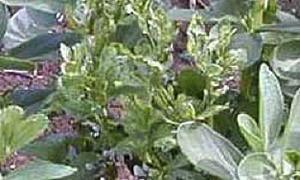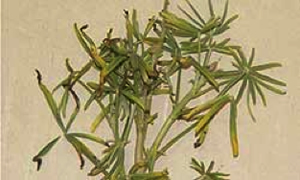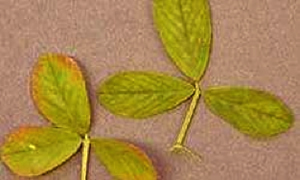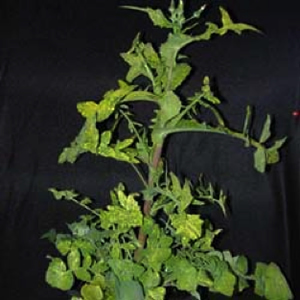Alfalfa mosaic virus
Alfalfa mosaic virus (AMV) was first identified infecting lucerne in the USA, and is now distributed worldwide.

The main source of this virus is lucerne, but it has a wide host range which includes the temperate pulses (chickpeas, faba beans, field peas and lentils) as well as pasture legumes and perennial weeds.
The virus is spread by a number of common aphid species, as well as being seed transmitted in some species.
What to look for
Symptoms on the infected plant depend greatly on the strain of virus, host variety, stage of growth at infection and environmental conditions.
In many species, a bright yellow mottle or mosaic develops. Local or systemic necrosis and stunting may also occur.
Some species recover from early infections. In some species seed size may be reduced. Symptoms in the major temperate pulses, pasture legumes and host weeds are:
- Chickpeas develop shoot tip necrosis.
- Faba beans develop chlorosis, necrosis and stunting of the new shoots. Leaf rolling, ring spots on leaves and general plant stunting may also occur.
- Lupins develop growth distortion, yellowing of top leaf tips and stunting.
- Lentils develop necrotic tip growth, twisting and deformation of leaves and stunting.
- Lucerne develops mottling or mosaic symptoms and reddening of leaf margins. Symptoms may disappear in summer.
- Field peas develop chlorosis and necrosis of the new shoots. Necrotic spots or streaking on older leaves and plant stunting may occur. Pods may be malformed and fail to develop peas.
- Subterranean clover develops vein clearing, chlorosis or necrosis of the leaves, and sometimes plant stunting.
- Common sowthistle develops a distinctive bright yellow mosaic on the leaves.

The symptoms caused by AMV can be confused with those of nutrient deficiencies, physiological disorders and herbicide damage.
Disease cycle
Transmission
AMV survives in infected seed or plant hosts. It does not persist in stubble or soil. Aphids spread the viruses from seed-infected plants to healthy plants. Seed transmission rates of 0.1 to 5 per cent in lentils and 0.1 to 1 per cent in chickpeas have been recorded (Jones and Coutts 1996).

The first tentative evidence for seed transmission of AMV in faba bean was reported with a transmission rate of 0.04 per cent (Latham et al., 2004). In Western Australia, seed transmission of AMV was detected in:
- Lathyrus cicera (2 per cent)
- Lathyrus sativus (0.9 to 4 per cent)
- Vicia benghalensis (0.9 per cent)
- Vicia narbonensis (0.1 per cent)
- Vicia sativa (0.7 per cent) (Latham and Jones 2001b).
AMV is also seed transmitted in lucerne seeds (0.4 to 1.9 per cent (Garran and Gibbs 1982).

AMV is transmitted from infected plants by aphids in non-persistent manner. This means that spread of the virus is generally over short distances, as aphids only remain infective for periods from a few minutes up to a few hours.
Although aphids rarely colonise chickpea plants, they still probe them as they move through the crop spreading the viruses.
There are over 20 species of aphid capable of transmitting AMV. During surveys of the Wimmera cropping region over a number of years the following aphid vectors of AMV were found:
- blue green aphid (Acyrthosiphon kondoi)
- cowpea aphid (Aphis craccivora)
- foxglove aphid (Aulacorthum solani)
- ornate aphid (Myzus ornatus)
- green peach aphid (Myzus persicae)
- spotted alfalfa aphid (Thryoaphis trifolii forma maculata).

Host range
AMV has a wide host range that is not limited to plants belonging to the Fabaceae family.
Temperate pulse hosts include:
- chickpeas
- faba beans
- field peas
- lentils
- lupins
- narbon beans
- grass peas
- vetch.

Pasture legume hosts include:
- lucerne
- burr medic
- other annual medics
- a number of clover species.
In Victorian pulse cropping areas, common sowthistle (Sonchus oleraceus) and blackberry nightshade (Solanum nigrum) were found infected.
AMV can also infect a number of horticultural and vegetable crop hosts.

Economic importance
Incidence of AMV within individual infected lucerne pastures was high, with 50 to 98 per cent of plants infected (Jones 2004). Late infection with AMV in faba bean cv. Fiord diminished shoot dry weight by 41 per cent and seed yield by 45 per cent. Plants infected early in the season recovered sufficiently so there was no significant yield losses (Latham et al., 2004).
In plants of lentil cv. Matilda, infection with AMV decreased shoot dry weight by 74 to 76 per cent, seed yield by 81 to 87 per cent and individual seed weight by 10 to 21 per cent (Latham et al., 2004).
Early infection with AMV killed plants of chickpea cv. Tyson while later infection decreased shoot dry weight by 50 per cent, seed yield by 98 per cent and individual seed weight by 90 per cent (Latham et al., 2004).
AMV was found in the majority of lucerne crops in surveys in New South Wales and ACT (Garran and Gibbs 1982).
Seed yield losses recorded due to infection of subterranean clover were 71 per cent with AMV (Jones 1992).
Surveys of pulse crops in the last 10 years indicate that AMV is an important virus disease of lentils, chickpeas and lupins in south eastern Australia.
Table 1: Percentage of pulse crops infected with alfalfa mosaic virus in south eastern Australia and within crop virus incidence
Virus Survey | Lentil | Fababean | Chickpea | Lupin | ||||
|---|---|---|---|---|---|---|---|---|
| State/Year | % of sampled crops infected | Within crop virus incidence range % | % of sampled crops infected | Within crop virus incidence range % | % of sampled crops infected | Within crop virus incidence range % | % of sampled crops infected | Within crop virus incidence range % |
Victoria | ||||||||
| 2000 | 2 | 1 | 6 | 1 | Virus not found | Virus not found | Virus not found | Virus not found |
| 2001 | 12 | 1 to 2 | Virus not found | Virus not found | Virus not found | Virus not found | Virus not found | Virus not found |
| 2004 | 26 | 1 to 7 | Virus not found | Virus not found | Virus not found | Virus not found | Crop not sampled | Crop not sampled |
| 2007 | 63 | 3 to 13 | Virus not found | Virus not found | 40 | 2 to 9 | 25 | 2 |
| 2009 | Crop not sampled | Crop not sampled | Crop not sampled | Crop not sampled | 42 | 1 to 9 | Crop not sampled | Crop not sampled |
South Australia | ||||||||
| 2001 | 17 | 17 | Crop not sampled | Crop not sampled | Crop not sampled | Crop not sampled | Crop not sampled | Crop not sampled |
| 2003 | 17 | 4-5 | Virus not found | Virus not found | Virus not found | Virus not found | Crop not sampled | Crop not sampled |
| 2004 | Virus not found | Virus not found | Virus not found | Virus not found | Crop not sampled | Crop not sampled | Crop not sampled | Crop not sampled |
| 2005 | Virus not found | Virus not found | Virus not found | Virus not found | Crop not sampled | Crop not sampled | Crop not sampled | Crop not sampled |
| 2006 | 100 | 8 to 60 | 100 | 3 to 28 | 100 | 9 to 25 | 88 | 4 to 30 |
| 2007 | 44 | 3 to 17 | 5 | 2 | 50 | 4 | 20 | 12 |
| 2009 | Crop not sampled | Crop not sampled | Crop not sampled | Crop not sampled | Virus not found | Virus not found | Crop not sampled | Crop not sampled |
New South Wales | ||||||||
| 2006 Southern | Crop not sampled | Crop not sampled | Virus not found | Virus not found | Crop not sampled | Crop not sampled | Crop not sampled | Crop not sampled |
| 2009 Southern | Crop not sampled | Crop not sampled | Crop not sampled | Crop not sampled | 71 | 1 to 18 | Crop not sampled | Crop not sampled |
| 2009 Northern | Crop not sampled | Crop not sampled | Crop not sampled | Crop not sampled | 49 | 1 to 12 | Crop not sampled | Crop not sampled |
In 2007 in Victoria, 23 per cent field pea crops were infected and the within-crop incidence of virus was 2 to 13 per cent. In 2006 in Southern NSW 13 per cent pea crops were infected with virus, and within crop virus incidence was 1 per cent.
Management
AMV is spread by sowing infected seed or by movement of aphid vectors from infected plants to healthy plants. Low levels of seed infection in pulses may lead to spread of AMV during years with high rainfall and a subsequent early build up of large aphid populations.
Chemical control of aphids is not an effective method for controlling AMV.
Sowing healthy seed, managing weeds and other cultural practices to minimise AMV spread are recommend, such as:
- growing crops adjacent to infected lucerne or pasture will increase the risk of crop infection
- retaining stubble is thought to reduce aphid landing rates and therefore virus spread, as aphids are attracted to bare ground
- sowing early, and at optimal seeding rates, to generate early canopy closure (early canopy closure will shade out weak plants grown from infected seed, and reduce in-crop spread of AMV by aphids).
Some seed companies sell lentil seed which has been tested for AMV and cucumber mosaic virus (CMV). Commercial seed testing companies will also test legume seed lots for seed-borne viruses such as AMV.
If farmers retain their own seed it should be selected from crops which do not have virus symptoms or evidence of aphids. See Seed health testing in pulse crops for a list of seed testing laboratories.
Further references
- Pulse Australia
- Winter Pulse Disorders: The Ute Guide
- Seed Health Testing in Pulse Crops (AG1250)
- Pulse Australia - Virus control in chickpea–special considerations
- Pulse Australia Tech-Notes Autumn 2010 - Chickpea "sudden death" in 2009
- Garran J and Gibbs A (1982) Australian Journal of Agricultural Research 33, 657-664
- Jones RAC (19920 Australian Journal of Agricultural Research 43, 1229-41.
- Jones RAC, Coutts BA (1996) Annals of Applied Biology 129, 491-506.
- Latham LJ, Jones RAC (2001a) Australian Journal of Agricultural Research 52, 397-413.
- Latham LJ, Jones RAC (2001b) Australian Journal of Agricultural Research 52, 771-790.
- Latham LJ, Jones RAC and Coutts BA (2004) Australian Journal of Experimental Agriculture 44, 57-63.
- Jones RAC (2004) Australian Journal of Agricultural Research 55, 757-764.
Contact
Dr Piotr Trebicki
Virologist – Horsham
03 5450 8301
Field Crops Pathology
Grains Innovation Park
110 Natimuk Rd
Horsham 3400
03 5450 8301
Or call the Customer Service Centre, 136 186
Image credits
Figure 2 courtesy J.Van Leur, DPI, NSW
Acknowledgement
Mohammad Aftab, Angela Freeman, Frank Henry. Support by the Grains and Research Development Corporation is gratefully acknowledged.